|
| Front page | | Contents | | Previous | | Next |
Nature & Environment 2003 – Theme: Water in Denmark
Clean groundwater – an endangered privilege
In Denmark drinking water can be abstracted directly from the groundwater. It is clean, and tastes good. But there is no guarantee that this will always be the case. At some
locations, the groundwater has been polluted. The quality of water in the groundwater aquifers is monitored closely, and continuous efforts are being made to protect the
aquatic environment in order that clean drinking water can also be provided in the future. The latest initiative was the adoption of the Action Plan for the Aquatic
Environment III.
In Denmark almost all drinking water is abstracted from groundwater resources. In the 1990s Denmark used almost 1 billion m3 of drinking water each year, corresponding to the water
volume of the ten largest lakes in Denmark. In 2002 consumption of drinking water amounted to approx. 650 million m3. About one-third is consumed by private households, one-third
by agriculture and horticulture, and one-third by industry and institutions. In the last decade the consumption of water has fallen by 40 per cent. In densely populated urban areas, for
instance the cities of Copenhagen, Århus, and Odense, the water abstracted exceeds the volumes recharged to the groundwater aquifers. Therefore the watercourses are drying out in
the summer, and the groundwater table is decreasing.
From groundwater to drinking water
Raw groundwater can be used directly for drinking water purposes at only very few locations. Before drinking water is supplied to consumers, it is aerated and filtered in order to
remove most of the naturally occurring iron, manganese, and methane. Most often, aeration and filtration is sufficient treatment.
Danes live on top of the water they drink. Waterworks are located throughout Denmark. This decentralised structure presents a lot of advantages: it contributes to good groundwater
and drinking water quality in large parts of the country, and it allows consumers to keep an eye on the quality and to identify possible solutions to pollution threats.
Most of the 3,000 large waterworks operate with borings that reach the groundwater 20-200 metres below the surface. In addition, approx. 70,000 private wells or borings, each
supplying less than 10 households, abstract water from layers of sand, gravel, and limestone close to the surface.
Denmark wants clean groundwater – not treated groundwater
Denmark wants to produce drinking water from unpolluted groundwater. This was the attitude of previous governments – and it still applies. However, waterworks find it increasingly
difficult to abstract high-quality raw water from the subsoil. The major contributors to groundwater pollution are nitrate, pesticides, and organic solvents. Nitrate and pesticides come
from cultivated fields, gardens, green and built-up urban areas, golf courses, and roadsides. Organic solvents come from old waste dumps, dry cleaning establishments, and industrial
sites.
Over the last 15 years, more than 700 waterworks have closed down because the quality of the raw water had become unacceptable.
Danish water policy is based on prevention and implementing measures at source. Of course cleaning is just one of a broad range of options available when identifying solutions to a
specific pollution problem. But it should not be the first choice of the waterworks when faced with polluted borings. In cases where it is neither technically nor economically feasible to
replace the polluted groundwater by clean groundwater, treatment can be a solution to the specific pollution problem.

Over the last decade, water consumption has fallen by 40 per cent, in part because of green taxes. The figure shows total water abstraction and consumption broken
down by common waterworks, commercial irrigation, and industry
Source: Geological Survey of Denmark and Greenland
The indicator shows the volumes of groundwater abstracted in Denmark since 1989, broken down by three main types: common waterworks (i.e. waterworks supplying at least 10
properties), commercial irrigation, and industry.
Over the last decade, the total consumption of groundwater has fallen by almost 40 per cent. In 2002 the total volume of groundwater abstracted was 653 million m3, or somewhat
less than in 2001. The pale green section of the column indicates that, of the total volumes abstracted, 410 million m3
was used for drinking water purposes, thus continuing the almost constant fall in private consumption since 1989. 98 per cent of drinking water is abstracted from groundwater aquifers,
and the remaining 2 per cent from surface water. The fall is partly due to green taxes on the price of water – an efficient water-saving incentive.
With the implementation of the EU Water Framework Directive, a number of new environmental targets for groundwater must be introduced in Danish law. When setting the targets, the
entire hydrological cycle, i.e. the impact of groundwater on other parts of the hydrological cycle, is considered. For instance the magnitude of the impact on surface water in
watercourses and lakes should not prevent compliance with the environmental targets set for groundwater.

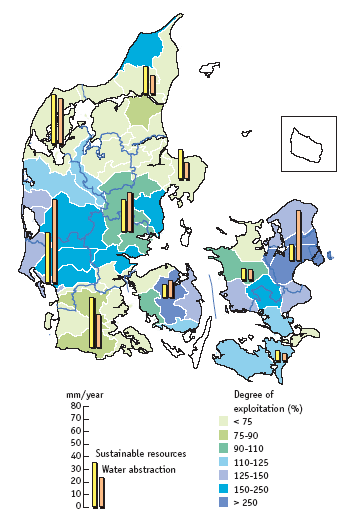
The figure illustrates the exploitable groundwater resources and how they are used. In densely populated areas and in areas of light soil requiring extensive irrigation,
the water is used more quickly than the aquifer recharge rate.
Source: Geological Survey of Denmark and Greenland
A new survey of the groundwater available for drinking water purposes estimates 1.0 billion m3
water is available per year. In earlier calculations this figure was 1.8 billion m3 per year. However, this does not indicate that the volumes available for drinking water, for instance, are
smaller than before. What it does indicate is that it is now possible to include the entire freshwater cycle in the calculations.
Thus, the survey assumes a maximum allowable magnitude of impacts on watercourses in relation to the existing objectives. This assumption forms the basis of the calculation of the
maximum groundwater abstraction.
Around large cities, the volumes of water abstracted today exceed the exploitable groundwater resources. In Northern Sealand and around Copenhagen, the groundwater resources
are being over-exploited by almost 80 million m3/year; on Funen by almost 10 million m3/year and; in Eastern Jutland by approx. 30 million m3/year. At some locations in the
Copenhagen area, more than three times the exploitable resources are being pumped up. These figures result from the fact that the calculation is based on environmental targets that do
not fully reflect the simple fact of nature that, when large volumes of water are abstracted, the water volumes available to safeguard recreational and natural interests are reduced.
Moreover, some of the upper groundwater aquifers are so contaminated that they cannot be used for a number of years. Pollution of the upper groundwater levels increases the need to
base water supply on deeper groundwater. Therefore, in the densely populated areas around Copenhagen, Odense, and Århus, and on light soils in Central and Western Jutland where
field irrigation is required, the volumes of water abstracted exceed the water recharged to the aquifers.
Water abstraction, and abstraction for irrigation in agriculture in particular, depends largely on the climate, and therefore the volumes pumped up vary greatly from one year to the next.
In 2002 abstraction for irrigation was modest, and in the areas in Southern Jutland and in Ribe and Ringkjøbing counties, where the need for field irrigation is considerable, the degree of
exploitation was well below 100 per cent. In dry seasons, when the need for field irrigation is large, for instance in 2003, the degree of exploitation increases considerably, to about three
times as much.
Groundwater and pollution
Groundwater in Denmark is surveyed and monitored in groundwater monitoring programmes, including upper and lower groundwater levels and control by waterworks of abstraction
wells. Most of the groundwater monitored predates 1990.
Organic micro-pollutants
Nitrate
As a result of the Action Plan for the Aquatic Environment I, adopted 1987, the content of nitrate in upperlevel and younger groundwater sampled in sandy catchment areas has
decreased, while in clayey catchment areas, the nitrate content has not declined. About 75 per cent of the abstraction wells contain less than 1 mg nitrate/l, and in only 1.1 per cent the
content of nitrate exceeds the 50 mg/l limit value. This is because abstraction wells suffering from excess nitrate will often be replaced by deeper borings, thus avoiding the polluted
groundwater. In the groundwater monitoring programme, about 16 per cent of the well screens show nitrate above the MAC (maximum admissible concentration) applying to drinking
water. The nitrate problem is greatest in the "nitrate belt" (Northern Jutland, Viborg and Århus) dominated by sandy soil. Also upper-level groundwater in other sandy soils shows nitrate
concentrations largely exceeding the MAC.
Inorganic trace elements
Inorganic trace elements occur naturally in groundwater. Where the acidity (pH) of groundwater is low, aluminium may occur in high concentrations. In aquifers without oxygen, arsenic
may be abundant in high concentrations. The occurrence of inorganic trace elements may also be due to contamination, or lowering of the groundwater level etc. High concentrations of
nickel present a local and increasing problem. In large waterworks with water treatment and efficient sand filters, inorganic trace elements will be partly removed, and concentrations
exceeding limit values in the groundwater abstracted will, thus, not always lower the quality of the drinking water. For individual wells and small common waterworks without water treatment, however, the trace elements may constitute a problem to the quality of the water.
Organic micro-pollutants, for instance chlorinated solvents and other typical industrial pollutants, have been found in almost two-thirds of the well screens in the groundwater monitoring
areas. In abstraction wells, organic micro-pollutants were found in more than one out of five wells. However, the concentration is below the MAC for drinking water in most of the
groundwater abstraction wells, as well as in most well screens in the groundwater monitoring areas.
Pesticides
The number of well screens with pesticides and their metabolites in the groundwater monitoring areas was approximately 27 per cent in both 2001 and 2002. The number of well
screens with concentrations above the MAC (0.1 μg/l) was about 9 per cent. Over the period 1990-2002 pesticides have been found in almost half of the well screens, indicating that
much of the groundwater is vulnerable to this pollution threat. In the period 1997-2002, pesticides were found in about 30 per cent of the abstraction wells. During the same period, the
number of wells with concentrations exceeding the MAC declined from approx. 10 to around 7 per cent. In 2002 pesticides or their metabolites were detected in more than 50 per cent
of the shallow (0 to 20 metres below ground surface) groundwater abstraction wells sampled. As in groundwater-monitoring areas, their occurrence decreases with increasing depth.
This indicates that today the upper groundwater layers are severely affected by pesticides.
A 2002 survey shows that about 36 per cent of the water abstracted contained pesticides. Waterworks analyse the raw water from wells affected by pesticides more often, and
therefore this figure may be somewhat exaggerated. Only about 4 per cent of the groundwater abstracted contained pesticides and their metabolites exceeding the MAC, and this may
indicate that the waterworks have closed a large number of wells with concentrations above the MAC.
Source: Geological Survey of Denmark and Greenland
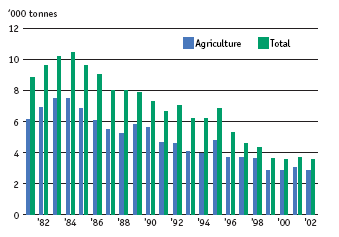
The overall quantities of pesticides sold in Denmark fell significantly in the period 1981-2002. The green columns show that sales decreased by one-third. The annual
quantities of pesticides sold to agriculture – the blue columns – more than halved.
Source: The Danish EPA
The indicator shows the trend in sales of pesticides in the period 1981-2002. The green columns represent the total quantity of all types of pesticides (plant protection products and
biocides, including wood preservatives) sold in the period. The blue columns are agriculture's share
of the pesticides sold.
From 1984, when sales peaked, to 2002, annual sales of pesticides to agriculture fell from 6863 tonnes to 2868 tonnes, a 58 per cent decrease.
In this period application frequencies fell from 3.2 to 2.04, or by 33 per cent. Application frequencies indicate how many times per year the pesticides sold can be applied to agricultural
land, when used in standard doses. Application frequencies thus reflect the application intensity by agriculture, and are indicators of the impact on the environment. Calculations show
that the consumption of pesticides fell more than the application frequency. The reason is that the pesticides used today are effective in much smaller doses, thus reducing consumption,
but not necessarily the impact on the environment.
Part of the explanation for the general decrease in sales of pesticides is the voluntary agreement between the local, regional, and state authorities, to introduce pesticide-free weed
control in public areas. Since 1995 consumption at local level has fallen by 74 per cent, at regional level by 79 per cent, and at state level by 42 per cent.
The Government's Pesticide Plan 2004-2009 sets the goal of reducing application frequencies to 1.7. The Plan also focuses on horticulture and fruit growing, and cultivation guidelines
and catalogues of methods to reduce the use of pesticides are being prepared. The objectives of the Plan also include the use of pesticides in private gardens.
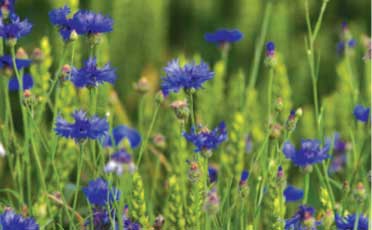
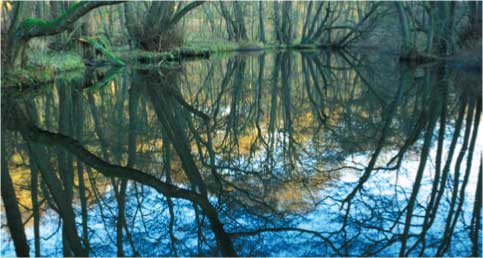
Afforestation protects the groundwater
The Government has decided that the forest area in Denmark should be increased to reach a forest cover of 20-25 per cent in the course of a tree generation (80- 100 years).
Generally, the quality of the groundwater generated below forests is good. As compared to agricultural land, forests are characterised by a permanent plant cover, limited use of
fertilisers, and no or very limited use of pesticides. In forests, runoff of nitrogen is less than 5 kg/ha/year. In 2001, the average runoff of nitrogen from agriculture was 76 kg/ha. This
shows that groundwater protection is a very important element in afforestation policies.
More forest
To reach the goal of a 20-25 per cent forest cover in Denmark within the next 80-100 years, approx. 4,500 ha of new forest must be planted every year. Today, forests are being
planted on only half of this area. In the 1990s new forest was planted at an average of 1,700 ha/year. In 2000 this figure was 3,000. The rather poor achievement is a result of the high
costs of both private and public afforestation, and therefore it is necessary to consider how these costs can be reduced, and whether, beside state funds, EU funds and private
unsupported afforestation efforts, other independent or supplementary financial sources can be mobilised. The afforestation objectives are based on long-term efforts, and there is time to
further consider aspects of both costs and funding.
Close to urban areas
Most of the forests are being planted at private initiative, but the Danish Forest and Nature Agency has initiated a number of afforestation projects, especially around large towns, and
sometimes in cooperation with local authorities and waterworks. State afforestation programmes aim at areas close to urban areas and, preferably, at locations where groundwater
interests should be safeguarded.
Source: Danish Forest and Nature Agency and Forest and Landscape Denmark
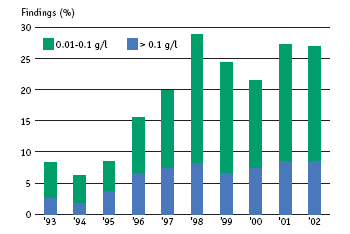
Pesticides or their metabolites are found in one out of three abstraction wells analysed. The indicator shows findings of pesticides in abstraction wells.
Source: Geological Survey of
Denmark and Greenland
The indicator shows the development of findings of pesticides and their metabolites in abstraction wells. The EU limit value for pesticides and their metabolites in drinking water is
0.1 mg/l. This limit value has been maintained on the basis that pesticides or their metabolites must not occur in drinking water. The limit value is not based on evaluations of impacts on
health.
In recent years the number of wells polluted by pesticides has remained almost constant. Pesticides are found in about one-third of the abstraction wells, and in almost one out of ten
wells the levels exceed the MAC value for drinking water. The number of polluted wells has not increased because of increasing pollution, but rather because analyses now include more
pesticides and metabolites than previously. When analysis programmes are revised the magnitude of impacts will probably therefore increase.
The aim is that water abstraction will continue to be based on clean groundwater that does not need special treatment. The pesticides and metabolites occurring most often in abstraction
wells are substances that are already banned in Denmark and have not been marketed for the last 8-10 years. The approved pesticides used today are monitored in the "Early Warning"
system, under which risks of leaching of approved pesticides into the groundwater are assessed.

Abstraction of drinking water from small abstraction plants
In 2004 the Geological Survey of Denmark and Greenland (GEUS) completed a survey of pesticide pollution of small waterworks, i.e. plants supplying less than 10 properties. The
small plants are either borings, wells, or borings in wells. Approx. 71,000 properties in Denmark are supplied with water from small water supply plants – supplying about 3 per cent of
the overall quantities abstracted for drinking water purposes.
In the study, four counties and GEUS analysed the water in more than 600 small water supply plants for the content of approx. 30 pesticides and their metabolites. The plants were also
analysed for bacteria and nitrate.
Results of the study
The study shows that many of the waterworks are polluted with pesticides. One or several pesticides and their metabolites were found in 58 per cent of the plants surveyed. In 36 per
cent the 0.1 mg/l MAC value for drinking water was exceeded. The metabolite BAM and the pesticide group triazines were found most frequently.
Most of the substances found are already banned in Denmark. In addition, the groundwater is protected by restrictions on the use of some of the other pesticides found in the survey.
The 0.1 mg/l pesticide limit value is based on a general precautionary principle, and also on the objective that pesticides must not occur in groundwater. The value is not based on health
considerations.
Another result of the survey is that other pollutants than pesticides are also contaminating many small water supply plants. The nitrate limit value is exceeded in 25 per cent of the
waterworks, and one or several indicator parametres for bacteria are exceeded in 50 per cent. As opposed to pesticides, the limit values for nitrate and bacteria are based on health considerations.
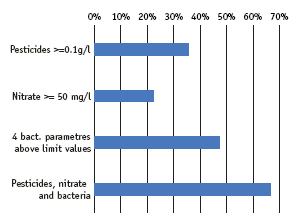
Causes of pollution
The Danish EPA has assessed that the small waterworks are often in very poor condition and that leaks in borings and wells may contribute to the extent of pollution. The Agency also
finds the problems are aggravated by other sources of pollution, for instance spraying and cleaning in farmyards or leaking sewage pipes located close to the waterworks.
Managing the problems
The Danish EPA has contacted Local Government Denmark with the aim of extending local inspection activities to include pesticides. The possibility of setting a maximum price for
connection to waterworks is also being discussed.
The Danish EPA will continue the investigation work launched in 2003, examining the possibilities for managing the problems of private wells and borings. Work will also include
assessment of the technical solutions available to improve the quality of water, for instance treatment of water from private borings.
Source: Geological Survey of Denmark and Greenland and the Danish EPA
| Front page | | Contents | | Previous | | Next | | Top |
Version 1.0 October 2004, © Danish Environmental Protection Agency
|